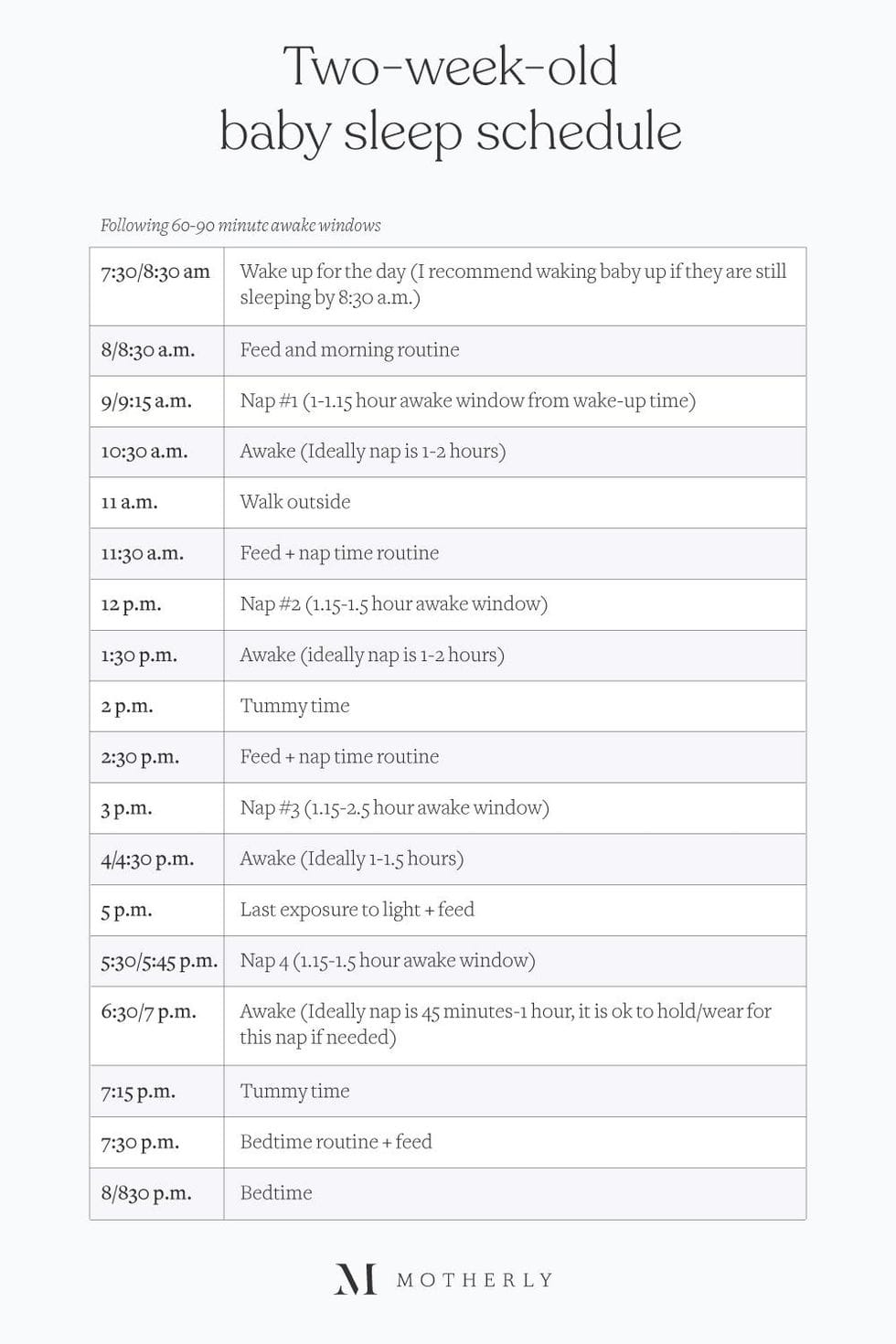How much sleep does a two-week-old baby need?

Rest easy: here's our guidance for your newborn baby's sleep.
Table of Contents
Your baby’s two weeks old! That first week might have felt like an eternity (mostly because you were awake for way more hours–way more hours in the day than you’re used to) and you may feel like you’ll never get in a rhythm, but as your little one continues to adjust to the world outside the womb, you’ll continue to adjust to motherhood. If it seems like your bundle of joy is sleeping at all hours of the day, don’t worry, that’s normal! This week, though, they’ll start being able to tell the difference between day and night, which is bound to make both of your lives easier.
We’ve put together a handy schedule that shows how much the typical newborn sleeps, as well as some tips on these early days of sleeping, to help you navigate these early weeks of newborn sleep. We know it seems overwhelming right now, but you’ve got this, mama!
Related: Baby Feeding Guides & Schedules
How much sleep does a two-week-old baby need?
You may not be getting much sleep these days, but your new baby needs lots of it: a newborn should get 14-17 hours of sleep per 24 hours, according to the National Sleep Foundation.
“At two weeks old, your baby’s sleep is very similar to week one, not changing much,” says Rachel Mitchell, a certified pediatric and maternity sleep consultant. “The only difference you may see is that your baby is starting to become slightly more alert than they were at week one. If you haven’t implemented a nap and nightly routine, I also suggest starting this now, as it will help all of you start to find a regular rhythm and help your baby become more prepared for sleep. Your nap routine should be about 15-25 minutes including a feed and your bedtime routine closer to 20-30 minutes.”
Mitchell also adds that in this stage, “it is completely fine to feed or rock your baby to sleep. A lot of parents worry that this will create bad ‘habits,’ but in this stage, your baby is not yet making those associations. You just want to make sure you aren’t feeding to sleep for every nap, at night, and for every wake-up. If you are starting to venture outside of the home, know that it is OK if your baby falls asleep in the car or the stroller, but you want to make sure that you are practicing safe sleep in these spaces, and that you can always see your baby. Remember that the safest and best sleep for your baby is always in their own environment in a crib or bassinet so while you don’t need to be home-bound, just do your best to plan outings around naps.”
Related: One-month-old baby milestones
Two-week-old baby sleep schedule
With all that sleep happening, you may be worrying about when you’ll have time to feed, change and engage with your little sweetie. That’s where we come in. We’ve put together a sample sleep schedule of what one 24-hour period with a two-week-old baby would look like.
(Note: this is meant to be a rough guide of what you can expect a day to look like, but it is not meant to be a sleep schedule you put your baby on.)

Wake windows for a two-week-old
The phrase “wake window” may be foreign to you now, but it’s something you’ll be conscious of for the next year-plus. A wake window is the period of time an infant can stay awake in between naps without getting overtired. Newborns are unable to self-regulate their sleep patterns, so instead of simply just falling asleep, they can become overtired.
Mitchell notes that for a baby this age, 60-90 minutes are the longest they will be able to stay awake.
Sleep tips for newborns
- Always place your baby on their back to sleep, not on the stomach or side. This helps to reduce the risk of Sudden Infant Death Syndrome (SIDS) and Sudden Unexplained Infant Death (SUID). The American Academy of Pediatrics initiated the “Back to Sleep” movement in 1992, and rates of SIDS/SUID have decreased dramatically since.
- Do not put anything else in the crib or bassinet. Keep plush toys, pillows, blankets, loose sheets, and bumpers out of your baby’s crib or bassinet for similar reasons as above.
- Avoid overheating. Even though they’re itty-bitty babies, you can dress them according to the room’s temperature. Don’t over-swaddle or over-layer their clothing.
- Try a pacifier. “You can also introduce the swaddle and pacifier at this stage to help promote sleep once the feeding relationship has been established,” Mitchell says. If they reject it, that’s OK. If it falls out, that’s OK.
- Use a white noise machine. Whether your house is quiet as a mouse, or you’ve got other kids running around making noise, a white noise machine can help your baby feel soothed (and possibly tune out) in their surroundings. Mitchell also says it “will help replicate that sound your baby heard frequently in the womb.”
- Snuggle it up. Your newborn wants your cuddles as much as you want to give them—especially if they’re fussy. Swaddle them up snugly, then rock them until they quiet down. There’s no such thing as holding a newborn too much (for safety reasons, don’t fall asleep with them in your arms).
A version of this story was published August 24, 2021. It has been updated.

































